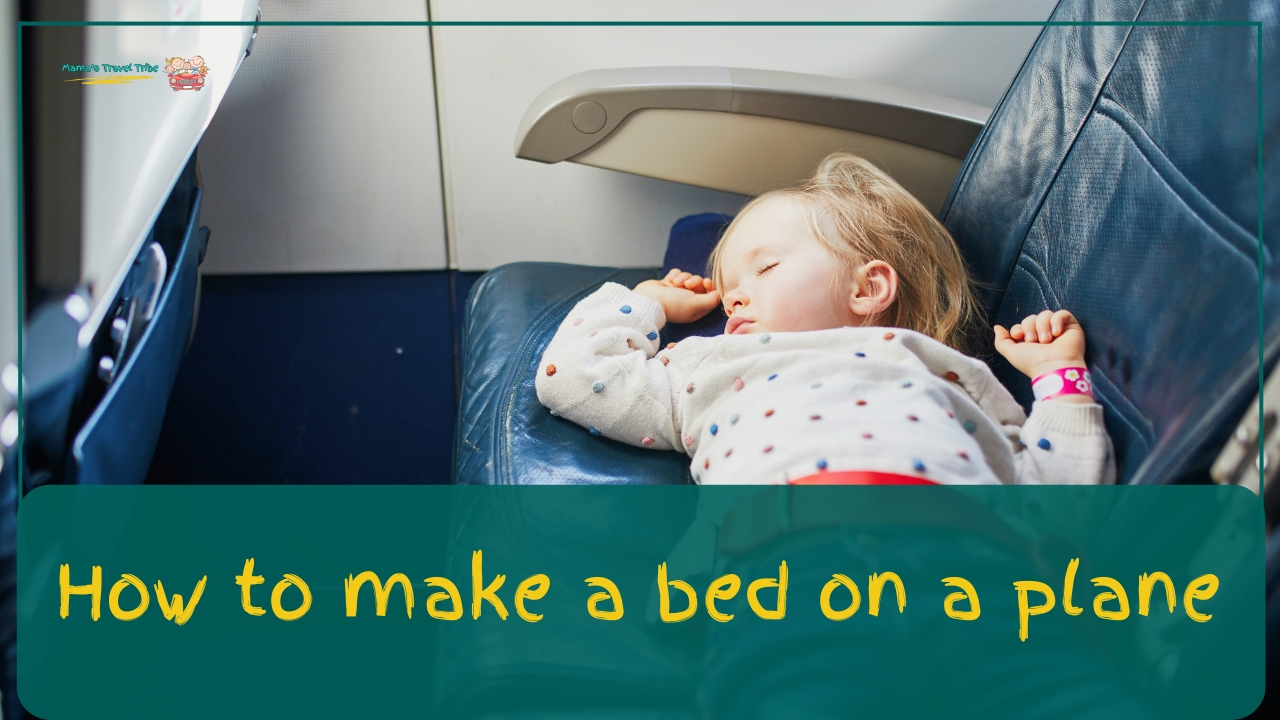Ever wondered “How to make a bed on a plane?” It’s not as hard as it sounds! You can do this with a few handy gadgets like seat extenders, inflatable footrests, and the right travel pillow. Don’t worry; stay till the end to find out how to travel in comfort, even in economy class!
How To Make a Bed on a Plane? (Ultimate Guide)
To make a bed on a plane, recline your seat fully, use a travel pillow for neck support. Then, place a blanket or large scarf over your seat and tuck it around you for warmth. Ensure everything is placed properly.
First, Understand the Basics of Airplane Seats
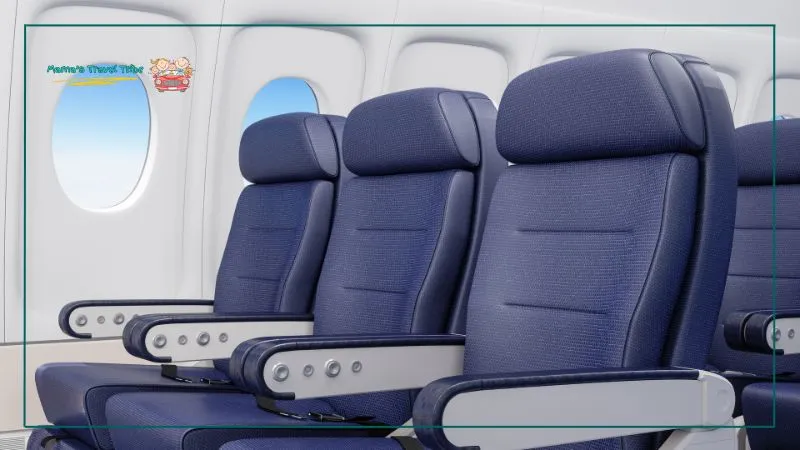
When you board a plane, the first thing you notice is your airplane seat. It might seem just a simple chair, but there’s a lot going on that can impact your comfort during a flight. The standard airplane seat in economy class is designed to maximize space, which often means minimizing comfort.
The good thing is that these seats are usually adjustable. This feature is crucial when you want to relax or take a nap. However, the limited recline can make it challenging to find a comfortable sleeping position. That’s where accessories like seat extenders and inflatable footrests come into play.
Using a seat extender can significantly increase your seat’s recline. I suggest it because it allows for a more bed-like posture. Pair this with an inflatable footrest, and you’ll notice a dramatic improvement in comfort. An inflatable footrest fills the gap between your seat and the one in front.
This setup supports your legs and aligns your body in a more natural sleeping position (similar to lying down in a bed).
Essential Items for Comfort
Creating a comfortable sleeping space on a plane doesn’t have to be complicated. Here’s a simple list of essentials that will transform your airplane seat into a cozy bed:
| Product | Description |
| Seat Extenders | Handy tools that increase the recline of your seat, making it more comfortable, especially in economy class. |
| Inflatable Footrests | Provides a platform for your feet, raises your legs, and helps align your body more horizontally, mimicking a bed. |
| Travel Pillows | Such as the Kimiandy inflatable travel pillow or the trtl pillow, these support the neck and prevent it from falling sideways, designed for comfort in tight spaces. |
| Travel Blanket | A lightweight but warm blanket that helps you feel snug and blocks out the chilly cabin air conditioning. |
Setting Up Your Space
Once you have your essentials, setting up your bed on the plane is straightforward:
- Install the airplane seat extender for adults/kids: Fit the seat extender under your seat according to the manufacturer’s instructions to maximize your recline.
- Place the Inflatable Footrest: Inflate the inflatable footrest and position it in front of your seat. Adjust it until it feels comfortable and supports your legs well.
- Arrange Your Travel Pillow: Whether you’re using the Kimiandy inflatable travel pillow for airplane, neck ai, or the TRTL pillow, make sure it’s comfortably wrapped around your neck or supporting your lower back, depending on your preference.
- Spread Your Blanket: Finally, drape your blanket over yourself to create a cozy, enclosed space that feels more isolated from the rest of the cabin.
With these items and a little setup, you’ll be amazed at how much more comfortable your airplane seat can become, even in economy class. Ready to try these tips on your next flight?
Adjust Your Seat
Start by adjusting your airplane seat. Push it back to its maximum recline. If it doesn’t go back far enough, attach a seat extender. This tool allows your seat to lean back further. It helps create a more comfortable angle for sleeping.
Set Up the Inflatable Footrest

Now, inflate your inflatable footrest. It’s easy to do—just use the pump or blow into it if it’s mouth-inflatable. Place the footrest on the floor right in front of your seat. Make sure it’s stable and fills the space well.
This setup raises your legs, aligning them with the seat. It simulates the flat surface of a bed, which is essential for comfort.
Arrange Your Travel Pillow
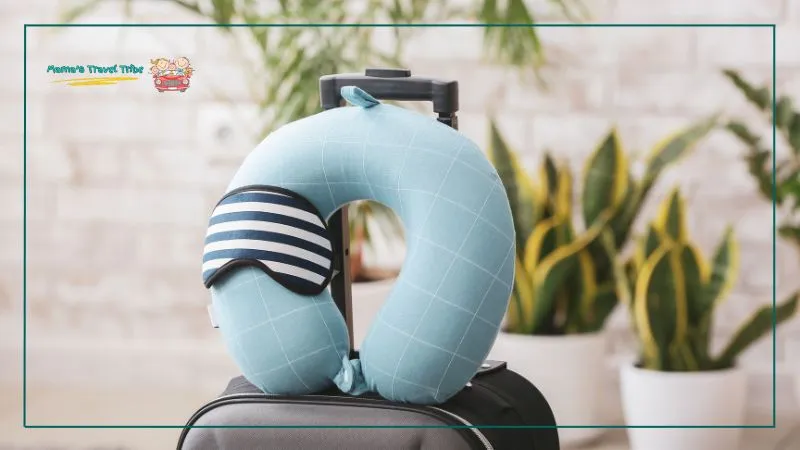
Choose a good travel pillow. The Kimiandy inflatable travel pillow for airplane, neck ai and trtl pillow is excellent for this. If you’re using the Kimiandy, inflate it and place it around your neck to support it.
If you prefer the Trtl, wrap it snugly around your neck or use it as lumbar support. These pillows are crucial as they prevent your neck from craning awkwardly, which can disrupt your sleep.
Lay Out Your Blanket
Take out a soft, lightweight blanket. Drape it over yourself, starting from your toes and pulling it up to your shoulders. A blanket not only keeps you warm but also helps to create a little private haven. It shields you from the cabin’s bustling activity and the chill of the air conditioning.
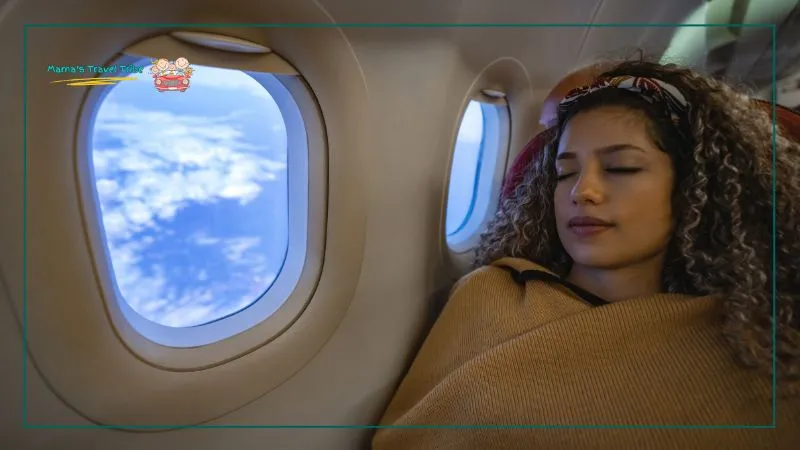
Final Touches
Before settling in, ensure everything feels comfortable and secure. That’s a crucial point in any toddler bed for plane diy guide. Adjust the footrest or pillow as needed. Make sure your blanket covers you well without falling off.
Now, you can enjoy your flight in your newly made bed. Even in economy class, you can achieve a surprisingly comfortable setup.
Making a comfortable bed on a plane is key, especially when traveling with little ones. But do you also need a car seat for them? Find out in Car Seat on a Plane for 4-Year-Olds: Essential Tips.
Best Products for Plane Beds: Seat Extenders and Inflatable Footrests
Seat extenders provide additional legroom by filling the space between your seat and the one in front. Inflatable footrests elevate your legs, promoting better circulation and comfort. Both products enhance sleep by creating a more flat and extended sleeping area, mimicking a bed-like experience on the plane.
Choosing the Right Seat Extender
A seat extender is a must-have for anyone looking to maximize comfort in an airplane seat. It allows the seat to recline further back, making it possible to lie down more flatly. Look for extenders that are easy to install and compatible with various seat types, especially in economy class.
Top Picks for Inflatable Footrests
Inflatable footrests are key to creating a bed-like space on your flight. They fill the gap between your seat and the seat in front, providing a level surface for your legs. Some popular choices include:
- Plane Pal: This is a versatile option that fits between the seat and the seatback in front of you. It’s easy to inflate and highly adjustable to suit your height and seating arrangement.
- JetKids BedBox: It’s ideal for long flights where children need to sleep comfortably.
Recommended Travel Pillows
A good travel pillow supports your neck and helps you avoid stiff muscles. Here are some highly recommended options:
- Kimiandy Inflatable Travel Pillow for Airplane, Neck Ai: This pillow inflates quickly and provides robust neck support, which is ideal for longer flights.
- Trtl Pillow: Known for its innovative design, the Trtl Pillow offers ergonomic neck support with a wrap-around style that’s easy to pack.
Why These Products Matter
These products not only improve comfort but also enhance your overall flight experience. They allow you to rest better, which can be crucial for arriving at your destination feeling refreshed.
When combined, a seat extender, an inflatable footrest, and a supportive travel pillow transform your cramped airplane seat into a cozy, sleep-friendly space.
How to Use the Flyaway Kids Bed for Children?
To use the flyaway kid’s bed for children, inflate the bed and place it in the footwell of your child’s seat. Secure it with the provided straps. Ensure the bed is properly inflated and stable before use. This creates a flat surface for your child to lie down and sleep comfortably.
What is the Flyaway Kids Bed?
The Flyaway Kids Bed is a revolutionary travel accessory designed to turn a standard airplane seat into a comfortable sleeping area for children. It’s an inflatable bed that fits right on the seat, providing a flat, secure surface for kids to lie down and sleep during long flights.
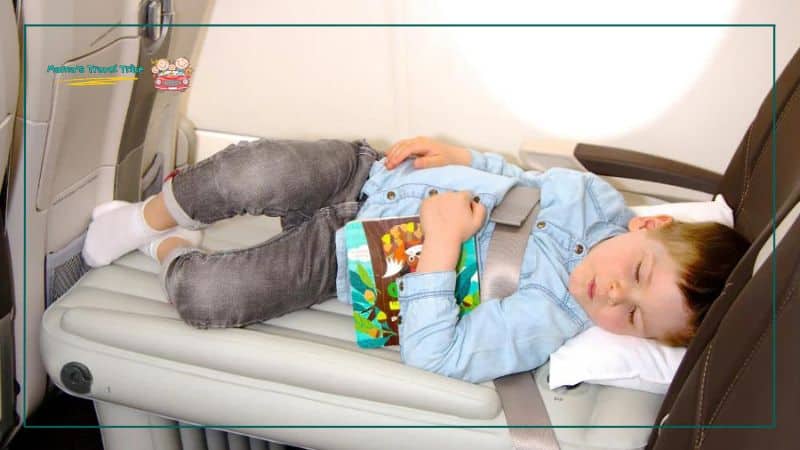
Setting Up the Flyaway Kid’s Bed
Setting up the Flyaway Kids Bed is straightforward:
- Check Airline Compatibility: Before your trip, make sure the airline allows the use of products like the Flyaway Kids Bed. Most airlines are accommodating, but it’s always best to check.
- Inflate the Bed: Once onboard, inflate the bed using a manual or battery-operated pump. It should fit snugly between the seat and the seatback in front of your child’s seat.
- Secure the Bed: Attach the bed to the seat using any built-in straps. This ensures it stays in place even if the plane moves around.
- Add Comfort Features: Place a small pillow and a lightweight blanket on the bed to make it cozy. You might also include a favorite stuffed animal or a small toy to help your child feel at home.
Benefits of Using the Flyaway Kids Bed
- Comfort: Provides a flat surface that mimics the feel of a regular bed, helping children to sleep better.
- Safety: Keeps children contained within their seat area during the flight, reducing the risk of falling.
- Convenience: Easy to carry and set up, making it an ideal solution for parents traveling with young children.
Tips for Best Use
- Test at Home: Before flying, try setting up the Flyaway Kids Bed at home so your child can get used to it.
- Nighttime Routine: Mimic your child’s bedtime routine as much as possible on the flight to help them settle down.
- Timing: Set up the bed as soon as the seatbelt sign is off to maximize sleeping time.
Using the Flyaway Kids Bed can greatly improve the flight experience for both kids and parents. It allows children to rest comfortably, which in turn helps parents relax and enjoy the journey.
Additional Tips for Enhancing Sleep Quality on a Plane
Wear comfortable, layered clothing and bring a neck pillow and blanket. Hydrate well, avoid caffeine and alcohol, and try to sleep in sync with your destination’s time zone. Use noise-canceling headphones or earplugs and an eye mask to block out light and noise.
Choosing the Right Seat
Opting for the right airplane seat can make a big difference in sleep quality. If possible, select a window seat for added head support and control over the window shade. It also minimizes disturbances from fellow passengers moving around.
Creating a Quiet Environment

To create a quieter, more restful environment:
- Use Noise-Canceling Headphones: These can block out engine noise and cabin chatter.
- Eye Mask: Wearing an eye mask helps block out cabin lights and visual disturbances, cueing your body that it’s time to sleep.
Maintaining Comfortable Temperature
Airlines often keep the cabin cool, which can disrupt sleep. To stay warm and comfortable:
- Layer Clothing: Wear comfortable, layered clothing that you can adjust based on the cabin temperature.
- Use a Travel Blanket: A soft, lightweight blanket not only provides warmth but also increases comfort and privacy.
Staying Hydrated
Drink plenty of water before and during the flight to stay hydrated. Avoid caffeine and alcohol. Why? Well, they can disrupt your sleep patterns.
Using Sleep Aids
Consider natural sleep aids to help you relax:
- Lavender Oil: A drop on your pillow or blanket can promote relaxation.
- Melatonin Supplements: Taking melatonin before a long flight can help adjust your body to a new time zone and encourage sleep.

Adjusting Your Meal Times
Adjust your meal times to align with the destination’s time zone. Eating according to your destination’s clock can help your body adjust more quickly to the new schedule.
These tips, when combined with the right sleep accessories like a seat extender, inflatable footrest, and travel pillow, can significantly enhance your ability to sleep well on a plane. Whether you’re traveling in economy class or with kids, these strategies are designed to help you arrive feeling rested and refreshed.
Once you’ve got the bedding sorted, you might be thinking about where to travel. Check out 20 Perfect Places to Travel with a 2-Year-Old: Family-Friendly Destinations for great vacation ideas.
Safety Considerations When Using Seat Extenders and Inflatable Rests
Ensure the extenders and footrests are securely positioned and do not obstruct aisles or emergency exits. Follow airline regulations and crew instructions. Avoid over-inflating, which could cause instability. Supervise children using these devices to prevent accidents or interference with other passengers.
Understanding Airline Policies
Before packing any sleep aid like a seat extender or inflatable footrest, it’s crucial to check with your airline. Each airline has its own policies regarding what is allowed in the cabin:
- Airline Approval: Always verify that the airline approves the use of devices like seat extenders. Some airlines might restrict their use due to safety concerns or cabin configurations.
- Installation Requirements: Learn about any specific installation guidelines to ensure your devices do not obstruct emergency exits or aisle access.
Using Seat Extenders Safely
Seat extenders can enhance comfort by increasing seat recline, but they must be used correctly:
- Proper Installation: Ensure that the extender is properly installed and does not interfere with the seatbelt or the reclining mechanism of the seat in front of you.
- Check Stability: After installation, check the stability of the seat extender to ensure it stays in place during the flight, particularly during takeoff and landing.
Handling Inflatable Footrests
Inflatable footrests are generally more flexible in terms of airline approval, but they still require careful use:
- Space Considerations: Make sure the inflatable footrest fits within your seating area without encroaching on others’ space or the aisle.
- Inflation Level: Adjust the inflation level to ensure it provides support while maintaining its integrity. Over or under-inflating can affect its efficacy and safety.
General Tips for Using Sleep Aids
- Communication: Inform the cabin crew that you are using a seat extender or inflatable footrest. They can assist in ensuring it’s used in compliance with safety guidelines.
- Consider Fellow Passengers: Be mindful of how your setup affects others. Ensure it doesn’t block their access to the aisle or their own seat controls.
- Quick Removal: Be prepared to remove or adjust your setup quickly in case of turbulence or in an emergency.
Understanding and adhering to these safety considerations can ensure that your flight is comfortable without compromising on safety. Using these aids correctly not only enhances your comfort but also aligns with the airline’s regulations, ensuring a hassle-free journey.
Top Travel Pillows for Optimal Neck Support
Travel pillows are essential for maintaining comfort and preventing neck strain during flights, especially long ones. Here’s a rundown of some of the best options on the market:
Kimiandy Inflatable Travel Pillow for Airplane, Neck Ai
- Design: This pillow inflates quickly and easily, forming a supportive U-shape around your neck.
- Benefits: It’s adjustable, so you can control the firmness to suit your comfort level. When deflated, it’s compact and lightweight, perfect for travelers who prefer minimal baggage.
- Ideal For: Long flights where space and weight are considerations.
Trtl Pillow
- Design: The Trtl Pillow stands out with its innovative fleece wrap design, which provides structured support in a soft, comfortable format.
- Benefits: It supports the neck through a hidden internal support system, which holds the neck in an ergonomic position during rest.
- Ideal For: Travelers looking for a non-traditional pillow that offers both comfort and support without the need for inflating.
Cabeau Evolution Classic Memory Foam Travel Neck Pillow
- Design: Made from high-quality memory foam, this pillow wraps completely around your neck, offering 360-degree support.
- Benefits: The memory foam contours to the shape of your neck, providing personalized comfort. It also includes a removable, washable cover for hygiene.
- Ideal For: Those who prefer maximum support and a snug fit around the neck.
Travelrest Ultimate Travel Pillow & Neck Pillow
People pick the “travelrest i-lene travel pillow the best neck accessory cabeau evolution classic memory foam travel neck pill en route pod travel pillow eye mask.” Here’s why:
- Design: This pillow has a unique lateral body cushioning and adjustable tether that offers all-around support not just for the neck, but also for the upper body.
- Benefits: It promotes proper head and neck alignment and can be used in multiple positions.
- Ideal For: Anyone needing versatile support, whether sitting in a window, middle, or aisle seat.
En Route Travel Pillow Eye Mask Combo
- Design: This combo includes a comfortable neck pillow and an eye mask, enhancing both neck support and light blockage.
- Benefits: It’s a great solution for those who want to block out cabin light while also supporting their neck.
- Ideal For: Flyers who are sensitive to light and need uninterrupted sleep.
Always remember that travel pillows significantly enhance comfort by preventing neck strain and facilitating better sleep on planes.
FAQs
How To Convert Airplane Seat To Bed for Toddler?
To convert an airplane seat to a bed for a toddler, recline the seat fully and use an inflatable footrest or Flyaway Kids Bed to fill the legroom. Next, layer blankets and use a travel pillow for comfort.
Don’t forget to secure your toddler with a seatbelt or harness.
How To Turn Economy Seats Into a Bed?
To turn economy seats into a bed, recline your seat as much as possible. Use an inflatable footrest to extend the legroom and create a flat surface. Add a travel pillow and blanket for extra comfort. Wear an eye mask and noise-canceling headphones to improve sleep quality.
Which Things to Avoid When Making a Bed on a Plane?
Avoid blocking aisles or emergency exits with your setup. Don’t over-recline your seat if it impacts passengers behind you. Avoid bringing overly bulky items that can cause discomfort. Don’t ignore airline rules and crew instructions for safety and comfort.
Conclusion
Transforming your airplane seat into a comfortable bed can drastically improve your flying experience. Here’s a quick recap of the essentials:
- Seat extenders and inflatable footrests turn a regular seat into a flat sleeping space.
- Travel pillows like the Trtl and Kimiandy ensure neck support and prevent stiffness.
- Proper setup is key—make sure everything is airline-approved and does not disturb fellow passengers.
- Safety considerations are crucial; always comply with airline policies regarding sleep aids.
- Kids’ comfort on flights can be enhanced with products like the Flyaway Kids Bed, ensuring they get the rest they need.
With these tips and the right tools, you’ll be able to enjoy a restful sleep on your next flight, no matter how long it is. Ready to try these out and turn your next flight into a restful retreat?

